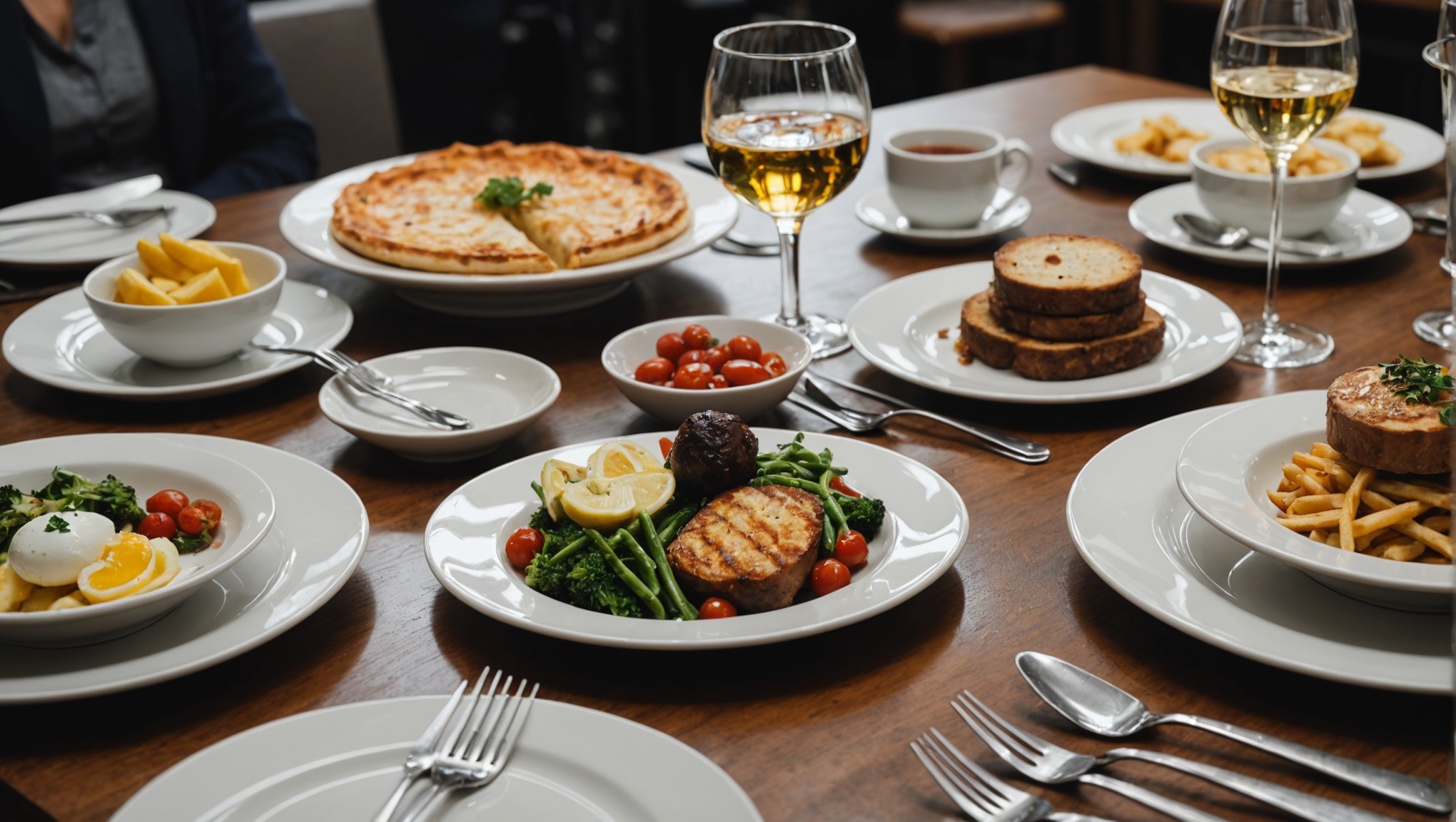Selecting the Perfect Tableware: A Guide to Enhancing Your Restaurant’s Theme
When it comes to creating a memorable dining experience, the tableware you choose plays a crucial role. It’s not just about serving food; it’s about setting the tone for your restaurant’s theme and making your guests feel like they’re part of something special. Here’s a comprehensive guide to help you select the perfect tableware and enhance your restaurant’s theme.
Understanding Your Restaurant Concept
Before you start selecting tableware, it’s essential to understand your restaurant’s concept and theme. This is the foundation upon which all your design decisions, including your menu and table settings, will be based.
Also to discover : The Impact of Restaurant Noise on Customer Satisfaction: Unraveling the Connection
“Your menu doesn’t have to be fancy or even unique: Whether you’re offering quick-service burgers or fine dining at its finest, strategically planning out your menu is a critical factor when it comes to restaurant profitability,” notes an article on restaurant menu planning.
Here are a few questions to consider:
Have you seen this : Boosting Family Restaurant Engagement: The Power of Interactive Tabletop Games
- What type of cuisine are you serving? If you’re running an Italian restaurant, you might opt for earthy tones and classic designs. For a Japanese restaurant, minimalist and sleek tableware could be more appropriate.
- What is the ambiance of your restaurant? Fine dining restaurants often use elegant and sophisticated tableware, while family-friendly restaurants might choose more casual and durable options.
- Who is your target audience? Understanding your customers’ preferences can help you make informed decisions about the type of tableware that will make them feel comfortable and appreciated.
Choosing the Right Tableware
The tableware you choose should reflect your restaurant’s theme and create a cohesive dining experience. Here are some key elements to consider:
Plates and Dishes
The plates and dishes are the centerpiece of your table setting. Here are a few tips to keep in mind:
- Material: Ceramic, porcelain, and glass are popular choices. Each material has its own unique feel and aesthetic. For example, ceramic plates can add a rustic touch, while glass plates can give a modern and sleek look.
- Design: The design of your plates should align with your restaurant’s theme. For instance, a fine dining restaurant might use plates with elegant patterns or simple, yet sophisticated designs.
- Size and Shape: Ensure that the plates are the right size for the dishes you are serving. A large plate for a small dish can make the portion look meager, while a small plate for a large dish can make it look overwhelming.
Glasses and Cups
The glasses and cups you use can also enhance the dining experience.
- Type of Glassware: Different types of glassware are suited for different beverages. For example, wine glasses, beer glasses, and water glasses each have unique shapes and sizes that enhance the drinking experience.
- Material: Glass is the most common material, but you can also use crystal or acrylic for a different look.
- Design: The design of your glassware should complement your plates and overall table setting. Simple, clear glasses can work well for most restaurants, while decorative glasses might be more suitable for special occasions or themed restaurants.
Silverware and Utensils
Silverware and utensils are often overlooked but are crucial for the overall dining experience.
- Material: Stainless steel, silver, and gold-plated utensils are common choices. Each material has its own feel and aesthetic.
- Design: The design of your silverware should match your restaurant’s theme. For example, a rustic restaurant might use wooden or bamboo utensils, while a fine dining restaurant might use elegant, polished silverware.
- Quality: Ensure that your silverware is of high quality and comfortable to use. Dull or flimsy utensils can detract from the dining experience.
Creating a Cohesive Table Setting
A well-designed table setting can make a significant difference in your guests’ dining experience. Here are some tips to create a cohesive table setting:
Use a Theme-Consistent Color Scheme
The colors you choose for your tableware should align with your restaurant’s theme and color scheme.
- Fine Dining: Often uses white, black, and neutral tones to create a sophisticated and elegant atmosphere.
- Family Style: Might use brighter, more vibrant colors to create a welcoming and casual atmosphere.
Add Decorative Elements
Decorative elements such as napkins, placemats, and centerpieces can enhance the table setting.
- Napkins: Choose napkins that match your tablecloth or placemats. You can also use napkin rings or holders to add a decorative touch.
- Placemats: Placemats can protect your tables and add a decorative element. Choose materials and designs that align with your restaurant’s theme.
- Centerpieces: Centerpieces can range from simple candles to elaborate floral arrangements. Ensure they are not too tall or obstructive, as they should enhance the dining experience without interfering with it.
Practical Tips for Selecting Tableware
Here are some practical tips to keep in mind when selecting tableware:
Durability
Ensure that your tableware is durable and can withstand the demands of a busy restaurant.
- Material Quality: Choose high-quality materials that are resistant to scratches, chips, and breaks.
- Maintenance: Consider how easy the tableware is to clean and maintain. Dishwasher-safe items can save time and effort.
Comfort
Make sure the tableware is comfortable to use.
- Weight: Plates and dishes should not be too heavy or too light. Silverware should be balanced and easy to hold.
- Ergonomics: Ensure that the handles of utensils are ergonomic and comfortable to grip.
Cost-Effectiveness
While it’s important to choose high-quality tableware, it’s also crucial to consider the cost.
- Budget: Set a budget and stick to it. High-quality tableware doesn’t have to be overly expensive.
- Longevity: Choose tableware that will last long, reducing the need for frequent replacements.
Examples of Tableware for Different Restaurant Themes
Here are some examples of tableware that might suit different restaurant themes:
Fine Dining
- Plates: White or cream-colored porcelain plates with elegant patterns.
- Glasses: Crystal wine glasses and clear water glasses.
- Silverware: Polished silver or gold-plated utensils.
- Decorative Elements: White tablecloths, fine linen napkins, and simple yet elegant centerpieces.
Family Style
- Plates: Colorful ceramic plates with casual designs.
- Glasses: Clear glassware for water and juice, and possibly colored glasses for a fun touch.
- Silverware: Stainless steel or wooden utensils.
- Decorative Elements: Brightly colored placemats, napkin rings, and casual centerpieces like vases with fresh flowers.
Rustic Charm
- Plates: Earthy-toned ceramic plates with rustic designs.
- Glasses: Mason jars or wooden mugs for a rustic feel.
- Silverware: Wooden or bamboo utensils.
- Decorative Elements: Burlap table runners, wooden placemats, and centerpieces like candles or potted plants.
Tableware Comparison Table
Here is a comparison table to help you visualize the different options:
| Restaurant Theme | Plates | Glasses | Silverware | Decorative Elements |
|---|---|---|---|---|
| Fine Dining | White porcelain with elegant patterns | Crystal wine glasses, clear water glasses | Polished silver or gold-plated | White tablecloths, fine linen napkins, simple centerpieces |
| Family Style | Colorful ceramic with casual designs | Clear glassware, colored glasses | Stainless steel or wooden | Brightly colored placemats, napkin rings, casual centerpieces |
| Rustic Charm | Earthy-toned ceramic with rustic designs | Mason jars, wooden mugs | Wooden or bamboo | Burlap table runners, wooden placemats, candles or potted plants |
Customer Feedback and Testing
Finally, it’s crucial to get feedback from your customers and test your tableware in real-world settings.
Prototype Testing
Create a prototype of your table setting and test it with a small group of customers. Ask for feedback on the comfort, aesthetics, and overall dining experience.
Iteration
Based on the feedback, refine your tableware selection. Continue to test and iterate until you find the perfect balance that enhances your restaurant’s theme and satisfies your customers.
Selecting the perfect tableware is a critical aspect of creating a cohesive and memorable dining experience for your guests. By understanding your restaurant’s concept, choosing the right materials and designs, and ensuring durability and comfort, you can enhance your restaurant’s theme and make every meal a special occasion.
As a restaurant owner, remember that “the menu planning process is actually one of the most complex you’ll go through as a restaurant business, because it combines business analysis with creativity and design”. The same principle applies to selecting tableware; it’s a blend of functionality, aesthetics, and customer satisfaction.
By following these guidelines and tips, you can create a table setting that not only complements your menu but also elevates the entire dining experience for your customers.






